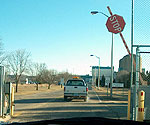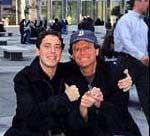By Mary Losure
Minnesota Public Radio
January, 2002
|
| RealAudio |
Before Sept. 11, the future of the nuclear industry seemed rosier than it had for years. But that may have changed in the post-attack world.
| |
|
|
|
||
May 2001 seems a long time ago now, but it marked a high point for the nuclear industry. In St. Paul, President Bush unveiled his new energy plan. He called nuclear power a "clean, and unlimited source of energy." He pushed for the construction of new nuclear plants, noting that the last U.S. plant was ordered in 1973. A New York Times editorial proclaimed that after "decades in the doghouse," the nuclear industry was "bubbling with new hopes and plans."
Four months later, a shadow fell across those plans. With the World Trade Center towers in ruins, a terrorist attack on a nuclear plant seemed a real possibility.
Within hours of the hijackings, the federal Nuclear Regulatory Commission advised the nation's 103 nuclear reactors to go on their highest state of security alert.
To nuclear critics like George Crocker, it seemed that layers of denial about the dangers of the industry had suddenly been stripped away.
"To me nothing became apparent after Sept. 11 except the fact that people were now willing to talk about it," Crocker said.
For the past 20 years, Crocker has headed the North American Water Office, an alternative energy advocacy group based in the small town of Lake Elmo, east of the Twin Cites.
In the mid 1990s, the group unsuccessfully fought the storage of high-level nuclear waste in steel casks at the Prairie Island Nuclear Plant near Red Wing. Now, Crocker says those casks are highly vulnerable to a terrorist attack.
| |
|
|
|
||
"It turns out that casks are only 9 inches thick, it's 9 inches of rolled steel. Now compare that to tank armor, what they call Chobham armor, which is steel plates, thin plates that are meshed together, so they're very, very durable. Tanks have 3 feet of chubbum armor. And the kind of weapons systems now available, they're single-man transportable devices that can penetrate 3 feet of Chobham armor. You guide them in with a joystick. They got over 4 kilometers of range. You don't need line of sight. Not only are the casks vulnerable, but also the pools," Crocker says.
Like the casks, the cooling pools at nuclear power plants store highly radioactive nuclear waste. Both casks and pools sit outside the highly reinforced concrete containment vessels that protect nuclear reactors.
Crocker raises the specter of an attacker blasting a hole in a cooling pool wall with a hand-held anti-tank weapon. "There are people who can shoot these things five rounds a minute - guide 'em right in there."
If the water drained quickly from the cooling pool, the radioactive waste could ignite in a catastrophic fire. An October 2000 report from the federal Nuclear Regulatory Commission estimates a fire in a cooling pool could cause as many as 20,000 cancer fatalities within a 100-mile radius.
Crocker says the containment vessels protecting nuclear reactors would be more difficult to penetrate, but they were not designed to withstand the impact of a commercial jetliner.
But the nuclear industry is confident of its ability to protect the public from such catastrophes.
At the Prairie Island plant, security measures are "robust," says security manager John Waddell.
At the gatehouse, guards have checked his i.d. and cleared his vehicle. Now he's steering his truck through a series of newly installed cement barriers.
"The purpose for these is to be able to control speed and also to able to create observations," he says. "Allow people time to screen us, observe us as we make our entry."
Waddell drives slowly toward the plant. It is surrounded by chain-link fence topped with barbed wire or gleaming coils of razor wire.
Waddell explains that anyone entering the plant must go through X-ray screening for metals and explosives. Since Sept. 11 the identities of all truck drivers making deliveries to the plant have been checked against pre-verified lists.
Asked about the security procedures protecting the casks and cooling pool, Wadfell replies that the details of plant security are protected information. Under federal law, he is not permitted to disclose how the company would deal with a terrorist wielding an anti-tank weapon.
"The best response I can give on that is that we feel very comfortable and confident in our ability to protect against those types of attacks here," he says.
Still, the Nuclear Regulatory Commission has begun a thorough review of security procedures at nuclear plants. NRC spokesperson Jan Strassma says the agency is trying to determine potential weakpoints at the nation's nuclear plants.
"Our review, our top-to-bottom review of the vulnerabilities and the security programs, includes not just the reactor containment but the entire reactor complex. So certainly we're looking at the spent fuel pools, we're looking at the dry cask storage areas, to determine if indeed there need to be changes made," according to Strassma.
Straasma says its premature to comment on what measures the agency might require, or what they could cost.
But Scott Denmen of the Washington D.C.-based anti-nuclear power group the Safe Energy Communication Council says the safety measures needed in the post-attack world could put marginal nuclear plants out of business and make a new generation of reactors economically unviable.
"If new reactors were required to have containments over the control room and the spent fuel pools and the dry cask storage areas and other sensitive areas, that could withstand the impact of a fully fueled 767 or 757 jet, I think the cost very likely might be prohibitive," Denmen says.
Steve Kerekes, a spokeman for the Nuclear Energy Institute, the nuclear industry's trade group, declined to comment on possible new security measures or their costs. He says that while the terrorist attacks have been a challenge to the industry, they have also provided a strong argument for expandingthe nation's reliance on nuclear power.
"I think one of the things that's been made perfectly clear from Sept. 11 is that there are some regions of the world that are extremely volatile and that also happen to be part and parcel of our nation's energy sources. We darn sure need to be positive going forward that we have a strong energy security component in our country," says Kerekes.
And Kerekes says he's confident the industry can build a new generation of reactors that can comply with the new security measures that may be required by the Nuclear Regulatory Commission.
More from MPR

